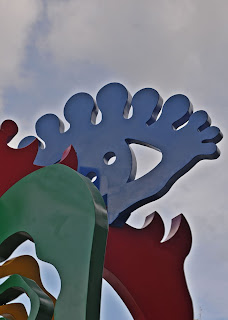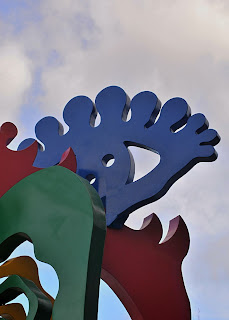
After watching "Ma Ma Mia" on Saturday night, which made us feel so old, we ventured out on a photographic tour to Blue Mountain Trail on Sunday, August 17, 2008. Taipei basin is surrounded by mountains. On its western side, between the Taiwan Strait and Taipei, is Yangminshan (陽明山). Blue Mountain Trail is half way up the western slop, facing Taiwan Strait, of Datun Mountain (大屯山). It is part of the Yangminshan Mountain systen. It crosses three mountain streams that suppose to be nice photographic spots.
We started our trip with a Cantonese brunch at top floor of Hotel RegaLees (福格大飯店) outside of TamKang University (淡江大學). It over looking Danshui river (淡水河), where it flows into Taiwan Strait. It was an alright restaurant not expansive that let us escaped the hot August sun. We even got free drinks at hotel lobby.
Blue mountain Trail for people unfamiliar with the region is very difficult to find. On the other hand, it is a well paved and maintained road, which the Shanzhi Township (三芝鄉) planted Taiwan mountain cherry trees all alone the road. It should be very pretty in the Spring. All three streams were very nice spot for water bathing. However, even with the fantastic "Picture Control" of our Nikon D40 and D300, the pictures came out very flat. It was only by reprocessing in Photoshop CS3 that I finally be able to brought out the color. The selected photographs from this trip is here.
Crossing one of the stream is a very old stone bridge (over 300 years old). It was formed by 3 pieces of stone slabs. It is thus call Sanban bridge (三板橋). When the wet air from Taiwan Straight moves up the Datung Mountain, it often forms very amazing clouds, we saw them at Sanban bridge and later on at Bailaka (巴拉卡路) road.
Bailaka road is famous bike road for the young and energetic cyclists. It goes up from Danshui River through Datun Mountain to Yangminshan, a close to 1000m climb. At one of the scenic spots we can over looking Xiaoyoukeng (小油坑) and Zhuzi Lake (竹子湖). Yangminshan has a very active geological structure, we could see the steam coming out from underground at Xiaoyoukeng. Zhuzi Lake is the valley under Xiaoyoukeng. It used to be experimental rice farm that Japanese developed the most important Taiwan Rice (蓬萊米) here. It is now mainly flower fields and restaurants. It is famous for picking Calla flowers (海芋) in spring.
The image at top of this blog is a composite of four RAW pictures from 70-300mm zone. Its original size is over 25 mega pixels. I was too lazy to change lens, thus took four pictures to cover the scene. Grace has another picture of the same scene of only 5 mega pixels using her 18-200mm zone. The two pictures looks the same on the web. On the other hand, I should be able to print my picture to 20 in x 25 in. Will I ever?






 ed the subject to completely black and the sky completely white, then the final image will really be the subject 100% from the lighter image and the sky 100% from the darker image.
ed the subject to completely black and the sky completely white, then the final image will really be the subject 100% from the lighter image and the sky 100% from the darker image.




